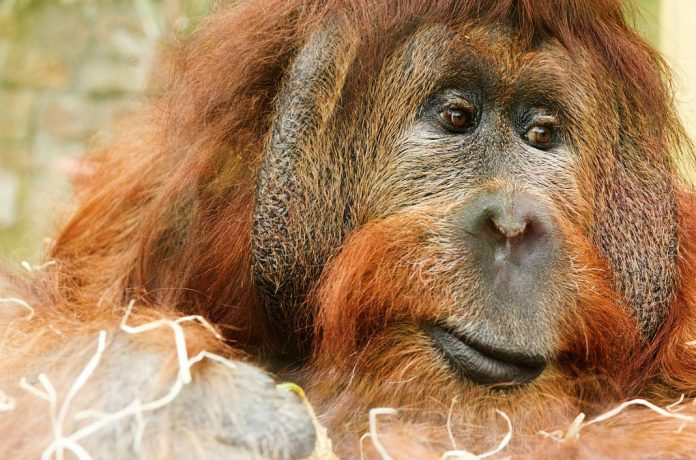“The Big House”, home to the University of Michigan’s American football team, is one of the world’s largest stadiums. Here’s what it looks like when packed to the brim with more than 100,000 rowdy spectators:
Authors of this article: Maria Voigt, Doctoral Researcher, Sustainability and Complexity in Ape Habitat, German Centre for Integrative Biodiversity Research; Erik Meijaard, Adjunct professor, Australian National University, and Serge Wich, Professor of Primate Biology, Liverpool John Moores University
Now, imagine replacing those people with Bornean orangutans. It’s a funny sight, isn’t it? Thousands of red-haired apes jostling in the stands.

Well, scientists just learned that at least 100,000 of these orangutans have disappeared over the past 16 years. And the worst part of this story is that all the remaining orangutans on the vast island of Borneo would only just about fill The Big House again one more time.
This finding is the result of our new study, published in the journal Current Biology, in which we investigated what has happened to orangutans in Borneo, the Southeast Asian island where most of them live.
We first gathered 16 years of survey data, collected both from researchers on the ground and from “aerial surveys” which used helicopters to identify orangutan nests high in the canopy. We then combined this with satellite images which indicated how the landscape has changed.
Our results show that the declines were steepest in areas that were deforested or transformed for industrial agriculture (often oil palm or paper pulp plantations), as orangutans struggle to live outside the forest.
Killing is at least as big a problem as deforestation
Worryingly, however, the largest number of orangutans were lost from areas where the forest remained intact or where only the tallest trees had been selectively logged. Here the species is in decline because it is hunted, just like any other edible animal on Borneo.
One analysis, based on interviews with 5,000 local people, found that few hunters would go out specifically to target an orangutan, and locals generally prefer deer and pigs. However, when an orangutan is encountered at the end of a long hunting day, a big orange primate sitting in a tree is a sitting duck or, more accurately, a sitting ape.
Orangutans are also increasingly killed when their forest habitat is cut down and they are pushed into people’s gardens and into plantations. People who encounter them there are scared or angry and resort to killing them.
Orangutans are very slow breeders. Previous research has indicated that a population will probably go extinct even if only one reproductive female per 100 adults is removed per year. But killing rates have been identified as being as much as three to four times higher than this, which would explain the immense losses seen within Borneo’s forests.
All is not lost
There is a positive twist to the story: there are actually more orangutans than we had previously thought. Some populations, in parts of Malaysian Borneo and larger national parks in Indonesian Borneo, even appear to be relatively stable and make it seem unlikely that the species will go extinct just yet.

And the more we learn about orangutans, the more we find that they are a resilient species that can adapt to new challenges. For example, our colleague Marc Ancrenaz has discovered that orangutans can cover large distances by walking on the ground, and that they adapt their diet to new resources such as acacia or oil palm. If they are not hunted, these abilities may allow them to survive in the fragmented landscapes that now make up most of Borneo.
Prevention is more important than rescue
People working on the ground know that the orangutan can be saved. It requires persistence, good collaboration with governments, strong support from local people, and help from companies that manage the land. Once forests are maintained and protected, and killing is stopped, orangutan populations can be stabilised. It might even allow them to slowly bounce back and recolonise forest areas where orangutans have disappeared in the past.
We need to think outside of the box. For instance, a lot of effort and funding goes towards rescuing individual orangutans, who are then moved to a safer place where they can be rehabilitated. But while this may help individuals in desperate situations, it is a very expensive and ineffective way to deal with the overall conservation problem. To put things into perspective, we lost more than 100,000 orangutans in the past 16 years and saved perhaps 1,000 through rescues, translocations and rehabilitation in the same period.
If we really want to stop the decline, we must both protect forests and stop the killing within them. As most orangutans live outside protected areas, we need to get the communities and companies who manage their habitats on board. Here, there are many possibilities. For example, one oil palm plantation is now protecting 150 orangutans within its concession, showing that oil palm is not inevitably linked to the complete destruction of primate habitat.
On a larger scale, the Malaysian state of Sabah and the Indonesian province of Central Kalimantan, both in Borneo, intend to certify their entire production of palm oil as sustainable by the year 2025, which includes a zero-killing policy. At the same time, both countries are developing new long-term action plans for orangutan conservation.
![]() We urge the governments of Indonesia and Malaysia to include firm strategies to stop the killing of orangutans. Because if we do not learn from past failures that stadium will eventually be empty, forever.
We urge the governments of Indonesia and Malaysia to include firm strategies to stop the killing of orangutans. Because if we do not learn from past failures that stadium will eventually be empty, forever.
This article was originally published on The Conversation. Read the original article.








